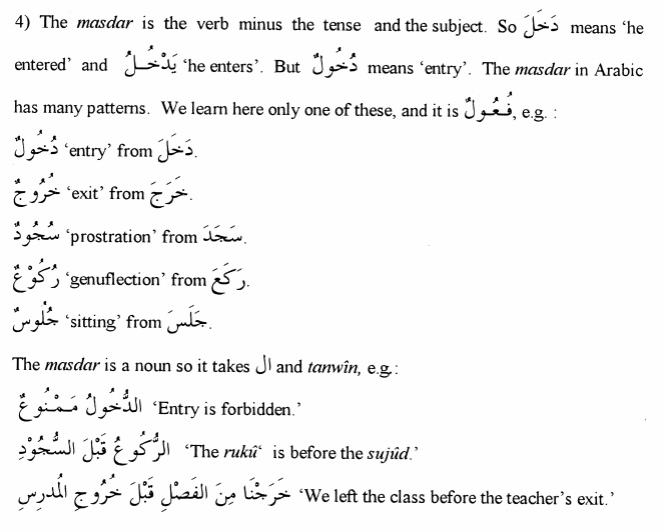03 Parts of Speech (Aqsam Al-kalimah/ أقسام الكلام) :
The Arabic ‘word’ (Kalimah/ كلمة) is divided into three types (Stated otherwise, every word in the Arabic dictionary falls into one of these three categories.) :
1. Noun (Ism/ إسم) : is the ‘ كلمة’ that gives a full independent meaning in itself and is not linked to time, e.g.رجل (man), بيت (house). The category is broader than ‘noun’ in that it also includes three others from the eight English parts of speech, namely pronouns, adjectives and adverbs.
2. Verb (Fil/ فعل) : is the ‘ كلمة’ that gives a full independent meaning in itself and is also linked to time, e.g.كَتَبَ (wrote), يَنصُرُ (helps). This is exactly the same as the ‘verb’ in English.
3.Particle (Har'f/ حرف): is the ‘ كلمة’ which has no independent meaning of its own i.e. can only be understood after coupling either a noun or a verb to it, e.g.في (in), على (on), و (and). This category includes prepositions, conjunctions, and articles.
Attachment 7069
- - - Updated - - -
04 Arabic Diacritic ( Al-Harakah , At-Tashkeel/ الحركات و التَشْكِي ) :
The Harakaat الحركات which literally means “motions” are the short vowel marks but Tashkeel refers to other vowel or consonant diacritics..
*
Fathah / ـَ /
The Fatha is a small diagonal line placed above a letter and represents a short /a/. The word Fatha itself means “opening” and refers to the opening of the mouth when any letter with this mark; e.g. كَـتـَبَ /kataba/ = to write.
*
Kasrah / ـِ /
A similar diagonal line below a letter is called a Kasrah and refers to a short /i/. The word kasrah literally means “breaking”; e.g. مـِـن /min/ = from.
*
Dammah / ـُ /
The Dammah is a small curl-like diacritic placed above a letter to represent a short /u/ or /o/; e.g. كـُـتـُـب /kotob/ = books. If the dammah is written with a following (و) /waw/, it designates a long /u:/ = /oo/ (as in the English word “blue”); e.g. بـُـومة /boomah/ = an owl. However, if the و /waw/ is pronounced as diphthong /aw/, a fatha should be written on the preceding consonant to avoid mispronunciation; e.g.
يـَوم /yawm/ = day.
*
Sukoon / ـْ /
The Sukoon is a circle-shaped diacritic placed above a letter. It indicates that the consonant to which it is attached is not followed by a vowel. The sukoon is a necessary symbol for writing consonant-vowel-consonant syllables which are very common in Arabic; e.g. مَدَدْ /madad/ = supply or support or aid. The sukoon may also be used to help represent a diphthong. A Fatha followed by the letter ى /yaa/ with a sukoon over the yaa indicates the diphthong /ay/ e.g. بـَـيـْت / bayt/ = home and the same with the other diphthong و /aw/ like in يـَوم /yawm/ = day.
Note :
The harakaat or vowel points serve two purposes:
(1) They serve as a phonetical guide. They indicate the presence of short vowels (fatha, kasra, or damma) or their absence (sukoon).
(2) At the last letter of a word, the vowel point reflects the inflection case or conjugation mood.
– For
nouns, The damma is for the nominative, fatha for the accusative, and kasra for the genitive.
– For
verbs, the damma is for the imperfective, fatha for the perfective, and the sukoon is for verbs in the imperative or jussive moods.
*
Hamza / ئ ؤ إ أ and stand alone ء /
The Hamza indicates a glottal stop accompanied by any of the above harakaat (fatha, kasra, damma or sukoon); e.g. أحمد = ‘Ahmad , هدوء = quietness
*
Maddah / آ /
The Maddah is a tiled-like diacritic (like the shadow of a bird flying) which can appear only on top of an alif / آ / and indicates a glottal stop (Hamza) followed by another alif representing the long /a:/ or /aa/ ;e.g. قـُرآن /Qur’aan/ = قرءان .
*
Dagger Alif / ـٰ /
The superscript or dagger alif الألف الخنجرية is written as a short vertical stroke on top of a consonant. It indicates a long alif /a:/ or /aa/ sound but the alif is normally not written. The dagger alif occurs only in a few words, but these words include some very common ones; e.g. الله /Allaah/
*
Tanween / ـٌ ـٍ ـً /
The three vowel diacritics may be doubled at the end of a word to indicate that the vowel is followed by the consonant /n/. These may or may not be considered harakaat and are known as Tanween or Nunation. The signs from left to right indicate /un/ or /on/ and /in/ and /an/. These symbols are used as non-pausal grammatical indefinite case endings in literary or classical Arabic.
*
Shaddah / ـّ /
The Shaddah or Tashdeed is a diacritic shaped like a small written Latin “w“. It is used to indicate germination (consonant doubling or extra length), which is phonemic in Arabic. It is written above the consonant which is to be doubled. It is the only harakah that is sometimes used used in ordinary spelling to avoid ambiguity .






